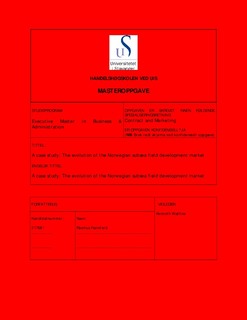A case study: The evolution of the Norwegian subsea field development market
Master thesis
Submitted version
Permanent lenke
http://hdl.handle.net/11250/2568470Utgivelsesdato
2018-05-25Metadata
Vis full innførselSamlinger
- Studentoppgaver (Business) [1023]
Sammendrag
The Norwegian sector has from the 70’s been dominated by the major international oil companies. Statoil was modelled after these international giants with both upstream and downstream capability. The sector has matured and the age of elephant discoveries have come to an end. The major oil companies are exiting while new operators are establishing following the 2005 “exploration refund model” instituted by the Norwegian government.
These new operators typically are modelled around oil and gas exploration and when time came to develop the fields they sought new strategies for performing the field developments they carved out a new path with alliances and design competitions between the SURF and the SPS contractors.
This thesis seeks out to review the current field developments by the new oil companies and how their strategy for development is changing the marketplace. It is doing the research by means of a case study of Subsea 7 and its marked interaction with the new oil companies.
The case study shows that the marked is splitting into Statoil and non-Statoil projects where the developments follow distinctly different strategies. The strategy from Statoil is to maximize competition, split developments into smaller packages and have a hard hand on the schedule to make all the contracts fit while the non-Statoil operators goes for fewer contracts with more collaborative approach into the development of the field development solutions.
The study further shows how the SURF and SPS contractors are collaborating on the field developments with the new oil companies in a way that is not representing their international alliances. The new oil companies drives cooperation’s that are not reflecting the international alliances, however reflecting the local Norwegian marked.
The cooperative approaches are analysed with interfirm governance theory, while early engagement is reviewed with regards to contractor’s value model (shop vs chain) and a brief look at potential for actor-oriented organisational models for the alliances and the limitations with hierarchical organisation forms.
Beskrivelse
Master's thesis in Business Administration: Executive MBA
